
Totem poles are monumental carvings, a type of Northwest Coast art, consisting of poles, posts or pillars, carved with symbols or figures. They are usually made from large trees, mostly western red cedar, by First Nations and Indigenous peoples of the Pacific Northwest Coast including northern Northwest Coast Haida, Tlingit, and Tsimshian communities in Southeast Alaska and British Columbia, Kwakwaka'wakw and Nuu-chah-nulth communities in southern British Columbia, and the Coast Salish communities in Washington and British Columbia.

Ketchikan Gateway Borough is a borough located in the U.S. state of Alaska. As of the 2020 census its population was 13,948, up from 13,477 in 2010. The borough seat is Ketchikan. The borough is the second most populous borough in Southeast Alaska, the first being Juneau Borough.

Ketchikan is a city in and the borough seat of the Ketchikan Gateway Borough of Alaska. It is the state's southeasternmost major settlement. Downtown Ketchikan is a National Historic District.
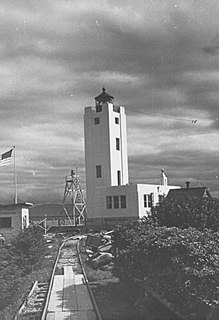
The Mary Island Light Station is a lighthouse located on the northeastern part of Mary Island in southeastern Alaska, United States.

The Tree Point Light is a lighthouse located adjacent to Revillagigedo Channel in Southeast Alaska, United States. It is located near the southernmost point of mainland Alaska.

The Alaska Governor's Mansion, located at 716 Calhoun Avenue in Juneau, Alaska, is the official residence of the governor of Alaska, the first spouse of Alaska, and their families. It was designed by James Knox Taylor. The Governor's Mansion was first occupied in 1912 by Territorial Governor Walter Eli Clark.

This is a list of the National Register of Historic Places listings in Ketchikan Gateway Borough, Alaska.
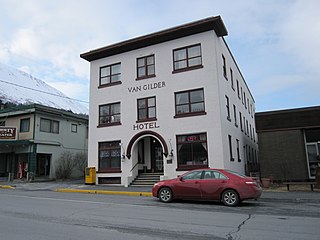
The Van Gilder Hotel is a historic multipurpose commercial and civic building at 307 Adams Street in Seward, Alaska, United States.
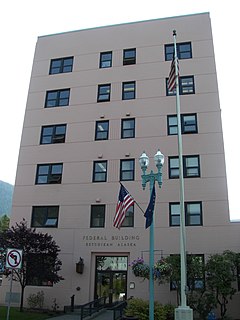
The Ketchikan Federal Building is a courthouse of the United States District Court for the District of Alaska, located at 648 Mission Street in Ketchikan, Alaska. It was completed in 1938, and was listed on the National Register of Historic Places on April 28, 2006. The building's primary tenant is the United States Forest Service Tongass National Forest Supervisor's Office, which occupies space on the first, second, third, fourth and sixth floors. The fifth floor houses a courtroom and related support offices, while the first floor also houses an office of the United States Customs and Border Protection.

Totem Bight State Historical Park is a 33-acre (13 ha) state park in the U.S. state of Alaska. It is located north of Ketchikan.
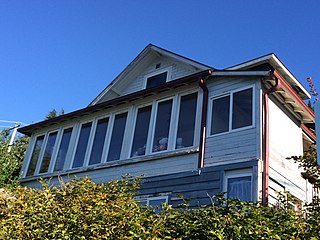
The Ketchikan Ranger House at 309 Gorge Street in Ketchikan, Alaska was built in 1916 in the residential Captain's Hill district of Ketchikan. Designed by USDA Forest Service in "Vernacular Victorian" style, it housed the U.S. Forest Service's district rangers until 1978. The 1+1⁄2-story frame house has remained essentially unaltered from its original construction. It was built for $650 to serve the first forest ranger for the state of Alaska.
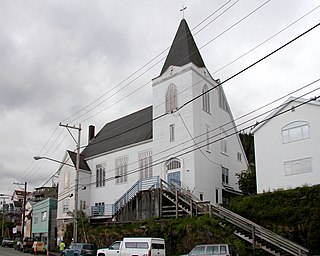
The First Lutheran Church in Ketchikan, Alaska is a historic church at 1200 Tongass Avenue. It was designed by architect W.G. Brust of Seattle and was built in 1930 by Ketchikan local builder Carl Foss. It is a two-story wood-frame structure, with a three-story tower at its southwest corner. The windows along the sides are rectangular sash windows on the first level, and narrow Gothic lancet windows on the taller second level grouped in threes in rectangular openings. The main entry is in through an arched opening in the tower, with the door topped by a multi-light transom window.

The Totem Heritage Center is a museum operated by the City of Ketchikan in the U.S. state of Alaska.

The Walker-Broderick House, also known as the "Doc" Walker House, is a historic house at 541 Pine Street in Ketchikan, Alaska. It was listed on the National Register of Historic Places in 1982. The house is a single-story wood-frame structure, built in 1916-20 by local Ketchikan master builder Carl Foss. The house is an excellent local example of Craftsman styling, with broad eaves supported by large knee arches, large brick piers supporting the front porch, and a matching brick chimney on the side. Interior woodwork is well-preserved. The house was built for Norman "Doc" Walker, an early Ketchikan resident, pharmacist, and politician who served as mayor and in the Alaska Territorial Senate

The Chief Shakes Historic Site is a historic collection of original and recreated Native Alaskan artifacts. It is located on Shakes Island, inside Wrangell Harbor, Wrangell City and Borough, Alaska. The most prominent feature of the site is a 1940 reconstruction of a Tlingit community house. This structure incorporates six original house posts, carved poles similar to totem poles. The house posts, four of which are from the community house of Chief Shakes, a line of like-named Tlingit clan leaders, are reported to be among the oldest known to survive. The house is surrounded by seven totem poles, two of which are original Tlingit work, and five of which are copies created by crews of the Civilian Conservation Corps that also built the house.

The Burkhart-Dibrell House, also known as Monrean House, is a historic house at 500 Main Street in Ketchikan, Alaska. This three story wood-frame house was built in 1904 by H. Z. Burkart, the founder of Ketchikan Spruce Mills, and is the only significant surviving Queen Anne style house in Ketchikan. It occupies a prominent position at the head of Main Street, and has long been a local landmark. In 1916, the house was purchased by Captain Walter Dibrell, Superintendent of Lighthouses for all of Alaska. The house's most prominent feature is its turret with conical roof and gold spire.
The Clover Pass School is a historic school building in Ketchikan Gateway Borough, Alaska. It is located 16 miles (26 km) north of the city of Ketchikan, at the junction of Potter and Knudson Cove Roads. The small one-room wood-frame structure was built in 1947, and was used as a one-room school until 1961. It thereafter was used as a local community center and is now owned by Historic Ketchikan.
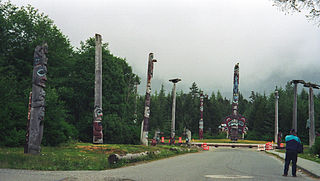
Saxman Totem Park is a public park in the city of Saxman, Alaska, just south of Ketchikan in southeastern Alaska. The park is home to a collection of totem poles, some of which are old poles relocated to this place from unoccupied Tlingit villages in the region, or were reconstructed by skilled Tlingit carvers under the auspices of the Civilian Conservation Corps in the 1930s. The poles originated in the communities of Old Tongass, Cat Island, Village Island, Pennock Island, and Fox Village. One of the carved items recovered from unoccupied villages is a marble statue of a grizzly bear. The park was listed on the National Register of Historic Places in 1979.
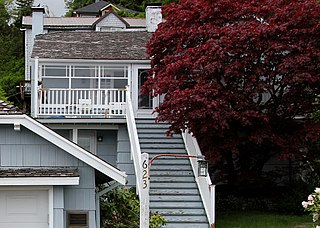
The Ziegler House, also known as the Ziegler/Pitcher House, is a historic house at 623 Grant Street in Ketchikan, Alaska. It is a two-story wood frame residence, set on a hillside. It is roughly rectangular in shape, with a hip roof with clipped-gable ends. The house was built as a relatively small structure in 1911, and underwent a significant expansion in 1922 to achieve its present appearance. The house has been the longtime home of members of the locally prominent Ziegler family, and was built by Adolph Holton Ziegler (1889-1970) who served as mayor of Ketchikan and in the territorial legislature. His son, Robert Holton Ziegler, became a prominent local lawyer, serving in the territorial and then state legislatures.

The Star is a historic commercial building at 5 Creek Street in Ketchikan, Alaska, United States. It is the only one of a once-numerous collection of brothels that famously lined Creek Street to retain its historical integrity, and was one of the largest in the city.






















